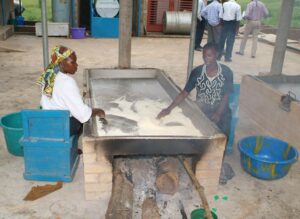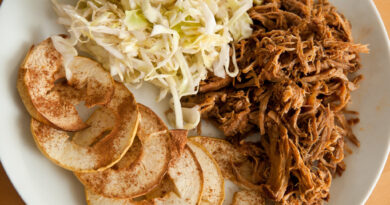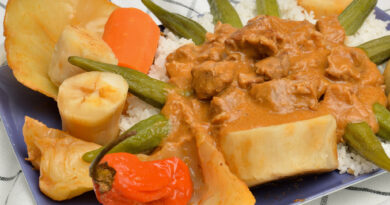Garri
The Legacy and Culinary Riches of Garri: Unveiling Nigeria’s Staple Food
In the bustling markets and kitchens of Nigeria, amidst the aroma of spices and the sizzle of pans, one staple food reigns supreme – Garri. This humble yet versatile foodstuff holds a special place in the hearts and palates of Nigerians, transcending social and economic boundaries to become a cherished aspect of the nation’s culinary heritage. From its historical roots to its modern-day significance, Garri embodies a story of resilience, adaptability, and cultural identity.
Historical Origins: Tracing the Roots of Garri
Garri, also known as cassava flakes, is derived from cassava, a starchy tuberous root native to South America but widely cultivated in tropical regions. The history of Garri intertwines with the migration and trade routes that shaped Africa’s cultural landscape. It is believed that cassava was introduced to West Africa by Portuguese traders in the 16th century, and since then, it has become an integral part of the region’s cuisine.
The process of transforming cassava into Garri is a testament to the resourcefulness of African communities. After harvesting, the cassava roots are peeled, washed, grated, and fermented for a few days. The fermented mash is then sieved to remove excess moisture before being roasted to produce the final product – coarse granules or fine powder, depending on the desired texture.

Culinary Significance: The Many Faces of Garri
Garri’s popularity stems from its versatility and adaptability. It serves as a staple food in Nigerian households, offering sustenance and satiety in various forms. One of the most common ways to consume Garri is by soaking it in water to create a thick paste known as “Eba” or “Gari fufu.” This starchy accompaniment pairs perfectly with a wide array of soups and stews, forming the cornerstone of traditional Nigerian meals.
Beyond its role as a mainstay in Nigerian cuisine, Garri has found its way into innovative culinary creations. Street vendors and home cooks alike experiment with Garri, incorporating it into snacks and desserts. “Garri soakings,” a popular street food, feature Garri mixed with sugar, milk, and sometimes groundnuts or coconut, offering a refreshing and energizing treat on hot days. Garri is also used in baking, adding a unique texture and flavor to bread, cakes, and cookies.
Nutritional Value: The Health Benefits of Garri
While Garri is primarily valued for its culinary attributes, it also boasts several nutritional benefits. As a product of cassava, Garri is rich in carbohydrates, providing a quick source of energy. It also contains essential vitamins and minerals, including vitamin C, vitamin B6, and potassium. Additionally, Garri is naturally gluten-free, making it suitable for individuals with gluten sensitivities or celiac disease.
However, it’s important to note that Garri’s nutritional profile can vary depending on factors such as processing methods and additives. Commercially produced Garri may contain added preservatives or flavorings, which can impact its nutritional value. As with any food, moderation is key, and Garri should be enjoyed as part of a balanced diet.
Economic and Social Importance: Garri in Nigerian Society
Beyond its culinary and nutritional significance, Garri plays a vital role in Nigeria’s economy and social fabric. The cassava value chain, of which Garri is a major component, provides employment opportunities for millions of Nigerians, from smallholder farmers to processors and traders. In rural communities, cassava farming serves as a source of livelihood, empowering individuals and contributing to poverty alleviation efforts.
Moreover, Garri holds cultural significance, serving as a symbol of Nigerian identity and resilience. It is deeply ingrained in social gatherings and ceremonies, from weddings to festivals, where it is shared among friends and family as a gesture of hospitality and camaraderie. In times of scarcity or hardship, Garri has served as a lifeline, sustaining communities through challenging circumstances.
Challenges and Opportunities: Navigating the Future of Garri Production
Despite its enduring popularity, the Garri industry faces several challenges that threaten its sustainability and growth. Issues such as post-harvest losses, inadequate processing facilities, and limited access to markets hinder the productivity and profitability of Garri production. Additionally, climate change poses a significant threat to cassava cultivation, as rising temperatures and erratic rainfall patterns affect crop yields.
However, amidst these challenges lie opportunities for innovation and collaboration. Efforts to improve agricultural practices, enhance value chain efficiency, and promote market access can bolster the resilience of the Garri industry. Furthermore, technological advancements, such as solar-powered dryers and mobile payment systems, hold promise for transforming the way Garri is produced, processed, and marketed.
Preserving a Culinary Tradition: Celebrating Garri’s Enduring Legacy
In a rapidly changing world, where food trends come and go, Garri stands as a testament to the enduring power of culinary tradition. Its humble origins and diverse culinary applications reflect the ingenuity and creativity of Nigerian cuisine. As we celebrate Garri’s legacy, let us recognize the invaluable contributions of the farmers, processors, and cooks who sustain this cherished staple food. Whether enjoyed as a simple meal or elevated to gourmet status, Garri continues to unite communities, nourish bodies, and preserve the essence of Nigerian culture for generations to come.



